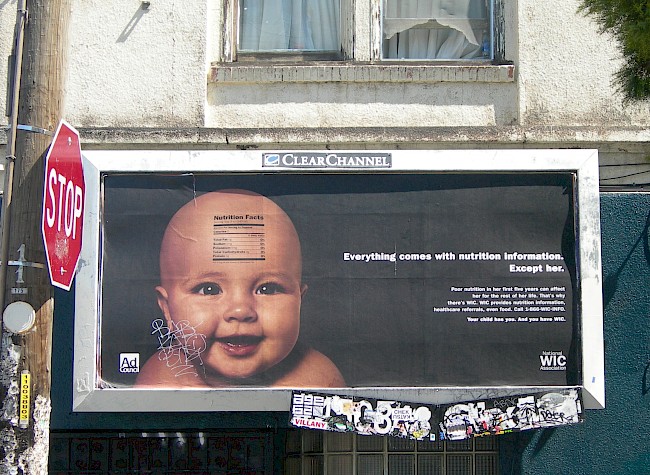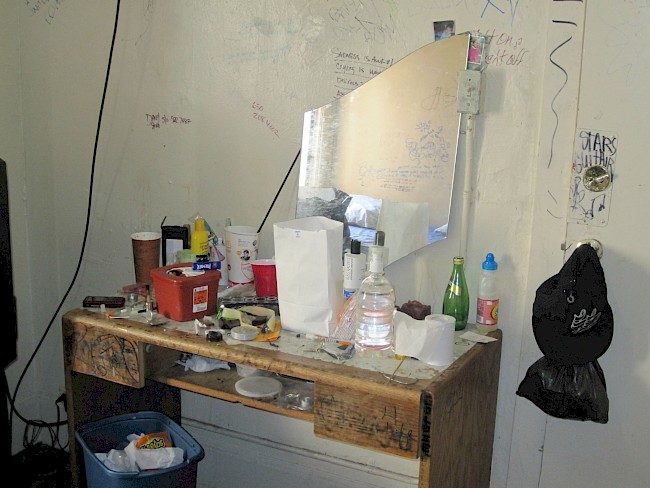addicted.pregnant.poor
—
Abstract
Introduction
Medical anthropologists are uniquely suited to examine the production of evidence about complex social problems. Our methods allow us to travel from the intimate, familial space of the home to the scientific laboratory to the halls of government as we chase our ethnographic objects. Each stop along the way reveals modes of knowledge production that carry potential as well as limits. Examining the intersection of these modes of knowledge production can reveal the rationalities of intervention and efficacy that locally adhere to evidence as it is leveraged in everyday, clinical, and policy domains.
Studying women who lived and worked in the daily-rent hotels of San Francisco’s Mission District, I followed the ethnographic object of addicted pregnancy as it traveled through multiple domains of evidence production (Knight 2015). In this setting, the radical availability of the urban poor for social scientific study raised both ethical and theoretical concerns. The ethnographic mode of witnessing revealed the affective, social, and structural circumstances of everyday homeless. Yet, it could also reproduce limited narratives of extreme social suffering. A science studies-informed interrogation of how the categories of ‘addicted’, ‘pregnant’, and ‘poor’ were constructed elucidated the biopolitics undergirding projects related to the efficacy of public health and housing policies. Yet, attending solely to public health research, clinical care, and bureaucratic practices could eclipse forms of meaning and relation that exist for addicted, pregnant, poor women both outside of and in conversation with those domains.
In this essay, I describe the relationship between the scientific contours of reproductive health and the personal and social consequences of pregnancy in the context of addiction and housing instability. The women I studied in the daily-rent hotels existed within multiple temporalities. Here I explore what an ethnographic understanding of memorial time and biomedical time can teach us about the vital politics of viability at work in addicted pregnancy.
Consumption and insecurity in the daily-rent hotels
The pregnant women I studied were made structurally vulnerable because their social legibility was dependent upon recognition by state apparatuses of institutional control; their lesser social status was determined by dual biologically manifesting constraints: first addiction, then pregnancy. The women’s everyday lives were organized by patterns of consumption and insecurity. They lived chaotic, dangerous, and debt-filled lives in the daily-rent hotels. They engaged in hustles in the drug-sex economy to avoid homelessness, manage their addictions, and deaden their rage. Pregnant women were constantly displaced within and between privately owned, daily-rent hotels that charged between $35 and $60 a day to rent a single room. None of the rooms had bathrooms and most look like those pictured here: dirty, broken furniture, chipped and peeling paint, often with blood stains and graffiti on the walls.
The patterns of consumption and insecurity found within the daily-rent hotels mirrored the contested terrain of the Mission District neighborhood, and the city itself, where rapid gentrification and increased policing are escalating already-heated discussions about who belongs here and under what circumstances.
Addicted pregnancy and time
Within this complex social fabric, an addicted, pregnant woman operated in multiple ‘time zones’ every day. She was on ‘addict time’, repeatedly searching for and satiating her addiction to crack and heroin. ‘Pregnancy time’ reminded her that her expanding womb was a ticking time bomb. On ‘hotel time’ the rent was always due. ‘Treatment time’ demanded she answer: When was she going back? Was it too late? Could the baby be born ‘clean’ if she stopped today? These are questions she asked herself and that were being asked of her. ‘Epidemiological time’ converted her previous experiences with trauma, violence, and risk into public health statistics. ‘Jail time’ reflected her repetitive relationship to carceral regimes. ‘Life time’ reminded her of her own history of childhood trauma and a life of addiction, homelessness, and institutional involvement. Studying addicted, pregnant women in the daily-rent hotels required recognizing how they were emotionally, physically, and structurally bound in a limbo state betwixt and between these temporal demands.
Memorial time and biomedical time co-constituted women’s pregnancies as they intersected with multiple institutions of care and control, revealing the precarious landscape upon which addicted pregnancy plays out among poor women in the United States.
Everyday memory objects in memorial time
In memorial time, memory objects helped to stabilize motherhood as a timeless experience within these sites of shifting temporality. Memory objects included photographs, recordings of children’s voices on cell phone messages, and children’s books and stuffed animals that women constantly carried around with them. Having conducted twenty years of research with drug-using women, I had heard the stories of losing children and failing as mothers, over and over and over again. So prevalent is the narrative that I can remember very few interviews with a drug-using woman that did not include it. The routine appearance of child-loss-trauma narratives could be largely attributable to what Judith Butler (2005) calls the ‘symbolic violence’ of interviews of this type. Women conform to the unwritten ‘rules’ of confession with institutional representatives who expect this trauma narrative and the associated affective sentiments it produces: sympathy on the part of the interviewer and the relief of moral burden on the part of the respondent.
The narrative is one thing. Seeing the narrative made symbol as a memory object – so matter-of-factly enlivened before you – is an entirely different, and greatly more emotional experience. This next fieldnote carries both aspects: the construction of the stigmatized mother-failure narrative and the enlivened memento literally attached to her body.
The picture frame, Mission Street, June 2007
I didn’t feel strange doing outreach, even though it was my first night. I integrated really well. People were friendly. One woman – I did have a bad reaction with a woman who was embarrassed. This is important, and I forgot it the first time I wrote my notes. She was somebody we met on the street and she was really high on crack, and she kind of singled me out as somebody who was laughing at her. I was smiling at her because I felt really, really awkward that she was so embarrassed of how high she was. She asked for supplies, and then she opened her coat and showed me a picture of her daughter. It was in a 4 by 6 inch frame that she was carrying around with her, in her hand the whole time we had been talking. ‘I always keep her here’, she said, cradling the picture carefully. Close to her heart. She didn’t hand it to me, for a closer look. She never let go of it.
It was such a sad gesture, a physical, material connection for her to a life that she wasn’t living anymore. And, she sort of, in a quiet voice, said, ‘You know, it’s not a, it’s not a good time, for me to be with her, right now’.
While women did not consider their memory objects to be the same as the child him or herself, the objects were very alive material representations of what they could no longer care for – at least not during their ‘addict time’. The child who cannot be here – right now – is very much here in the photo. One telling example was provided by Ramona.
‘Make sure it is just us’, Mission Street, January, 2010
On our way to the hospital to visit her newborn, prior to checking into residential treatment, we stop at McDonald’s. ‘Take a picture of me and DeLoni’, she asks me. I am a bit confused by this request at first. DeLoni isn’t here. Then she pulls out a picture of DeLoni, her daughter now seven years old, who lives with a relative in another part of the state. She holds it very close to her face. ‘Make sure it is just us’, she says. I take the picture and she wants to see it. I show her and she frowns. – ‘No that is not what I meant. Just us, our faces’. I take another picture. ‘No, that’s not right’, she says viewing the second picture. ‘I want it to look like she is here. With me’. I finally get it. She wants the picture to create the illusion that her daughter is there in McDonald’s. She wants to document her and her daughter in the same place, at the same time, which they cannot be.
For addicted, pregnant women in the daily-rent hotels, memory objects helped to reconfigure the traumatic event of child loss in the present, and represented an imagined future of regaining custody and getting another shot at mothering a specific child. Importantly, the woman holding the picture frame said she couldn’t be with her daughter ‘right now’ –she didn’t say ‘not ever again’.
The technocratic trace of biomedical time
The memorial practice that complemented the making and keeping of memory objects was the construction of biomedical memories through mechanisms of institutional intervention and surveillance. Immediate and longer-term custody of children was calibrated in direct relationship to the ways in which biomedical time came to be written.
While memory objects were often carried with women as they were displaced through illegal evictions and moved from hotel to hotel, biomedical memories existed elsewhere – in electronic hospital charts, in child welfare offices, and at family courts. Centered upon the fetus and its future viability, biomedical memories produced time-limited narratives of pregnancy, birth, and post-partum. Prenatal care records, blood and urine tests, and the quantification of in utero exposure to addictive substances all formed the biomedical memory of a fetus then child. Pregnant women, physicians, psychiatrists, and child welfare workers each referenced fetal biomedical memories as markers of maternal competence and custody justification in the pre- and postpartum periods. One clinician told me:
Pregnancy isn’t a long time. It may seem like nine months is a long time. But to get women stabilized on methadone, to get them prenatal care, to deal with their housing issues, get them to sign up for Medical, get a psych evaluation and follow-up if they need it, so they can deliver a baby with only methadone onboard and not get a Child Protective Services, or CPS, case? It is rarely enough time.
The material symbols of biomedical time – in the form of scores, urine tests, charts, and recommendations – provided a technocratic trace. Yet, biomedical time was itself scientifically unstable. The detection of exposure to crack cocaine in newborns often leads to immediate temporary termination of parenting rights and the child becomes a ward of the state. Yet, there is a great deal of scientific controversy about the short- and long-term effects of crack cocaine exposure on fetal health and later child development. In terms of intrauterine opioid exposure, there can be a wide range of responses to detoxification treatment for opioid dependency, or DTO. Some children born with higher scores detoxify relatively quickly, while others with lower neonatal abstinence scores require longer opioid treatment periods before withdrawal symptoms dissipate.
Yet, the number matters. CPS workers used the number as one quantifiable reflection of an addicted mother’s parenting potential. Fear over losing custody of their children leads most women who use drugs, not just homeless women, to avoid prenatal care. Every state in the United States has a surveillance system in place to identify prenatal exposure to substance use. Seventeen states consider substance use during pregnancy to be child abuse. Three states consider it grounds for civil commitment or incarceration. Having a previous baby born ‘dirty’ – with a positive toxicology test (‘tox screen’) – marks a woman with a residual biomedical trace that carries into subsequent parenting custody negotiations. For example, Ramona used her jail time to detoxify from crack and access methadone, so only methadone appeared on her son’s birth tox screen. She was furious that the CPS worker could use her ‘history’ of child custody loss against her in her current custody case.
Speaking of her newborn son, Ramona said:
His tox screen was clean! You hear what I am saying? The CPS worker is a straight bitch. She said, ‘We are going on your history’. ‘That’s the only reason why I have a case! His tox screen was clean!’ ‘Your history’, she said.
He is only five days old… . And DeLoni, remember DeLoni was on six. She was on six DTO [detoxification treatment for opioid dependency].[note 1] He is only on 2.5. So he is doing really good, you know what I mean? How can they go on my history when his tox screen was clean?’
A vital politics of viability
I engaged with all the social actors who are called upon to produce knowledge about addicted pregnancy, including women who were addicted and pregnant, an anthropologist, public health epidemiologists, advocates, social policy makers, treatment professionals, bureaucrats, and scientists. I analyzed what evidence matters in addicted pregnancy and what that evidence is made to do.
For women in the daily-rent hotels, the radical uncertainty of a pregnancy’s outcome was mediated by the everyday realities of poverty and addictionand the techno-scientific domains of medicine and child welfare. The multitude of ways in which addicted, pregnant women came to interact with and avoid systems of care and control throughout their pregnancies is demonstrative of ‘stratified reproduction’ at work in the United States. The term ‘stratified reproduction’ was first coined by Shellee Colen, and then applied broadly by Faye Ginsberg and Rayna Rapp, as a concept to ‘describe power relations by which some categories of people are empowered to nurture and reproduce, while others are disempowered’ (Ginsburg and Rapp 1995, 3).
Georges Canguilhem has famously argued that the coproduction of pathology and health is the result of responses – successes and failures – to the experience of external environmental pressure. Extrapolating from the petri dish to broader society, he writes: ‘Everything happens as if a society had “the mortality that suits it”, the number of the dead and their distribution into different groups expressing the importance which society does or does not give to the protraction of life’ (Canguilhem [1966] 1989, 161). One might be tempted to wonder if a society also has a ‘maternitythat suits it’? The management of pregnant, addicted women can tell us a great deal about social valuation and allowable social failure.
How then might we best theorize the vital politics of viability at work here? On the organic level, viability is related to fetal thriving, referencing the possibility for a living child as a result of a pregnancy. On the practicable level, viability addresses efficacy, effectiveness, and intervention. Is it a viable plan? Is it realistic, given the context of its implementation? Social and public health interventions in relation to prenatal care, housing, drug treatment, incarceration, and welfare entitlements all attempted, with varying degrees of success, to respond to both these registers of viability. Taken together and extrapolated to the philosophical level, a vital politics of viability for addicted pregnancy asks, ‘What forms of life are possible here?’ Placing diverse evidentiary claims about the everyday life and institutional involvements of addicted, pregnant women in conversation with each other allows us to address this larger question.
Requiring women to take individual, personal responsibility for themselves and their unborn children came into conflict with institutional regulatory mechanisms that did not sync with the temporal constraints of addicted, pregnant women’s lives in the daily-rent hotels. Everyday memory objects and biomedical memories told distinct yet convergent stories about the reconstitution, over time, of addicted, pregnant women vis-à-vis larger state systems of aide and adjudication. Taken together they spoke volumes about the hopes – often deferred – of women who find themselves categorized as addicted, pregnant, and poor.
About the author
Kelly Ray Knight is Assistant Professor in the Department of Anthropology, History and Social Medicine at the University of California, San Francisco. Dr. Knight is currently conducting several ethnographic research projects funded by the US National Institutes of Health exploring opioid misuse, clinical uncertainty, kinship, and housing instability across the lifespan. Her ethnography, addicted.pregnant.poor was awarded the British Sociological Association’s Foundation for the Sociology of Health and Illness 2016 Book Award and was a 2015 C. Wright Mills Award finalist.
References
Butler, Judith. 2005. Giving an Account of Oneself. New York: Fordham University Press.
Canguilhem, Georges. (1966) 1989. The Normal and the Pathological. Brooklyn, NY: Zone Books.
Ginsburg, Faye, and Rapp, Rayna. 1995. Conceiving the New World Order: The Global Politics of Reproduction. Berkeley: University of California Press Books.
Knight, Kelly Ray. 2015. addicted.pregnant.poor. Durham, NC: Duke University Press.
Endnotes
1 Back
These numbers refer to the scale of the assessment of neonatal abstinence syndrome.


